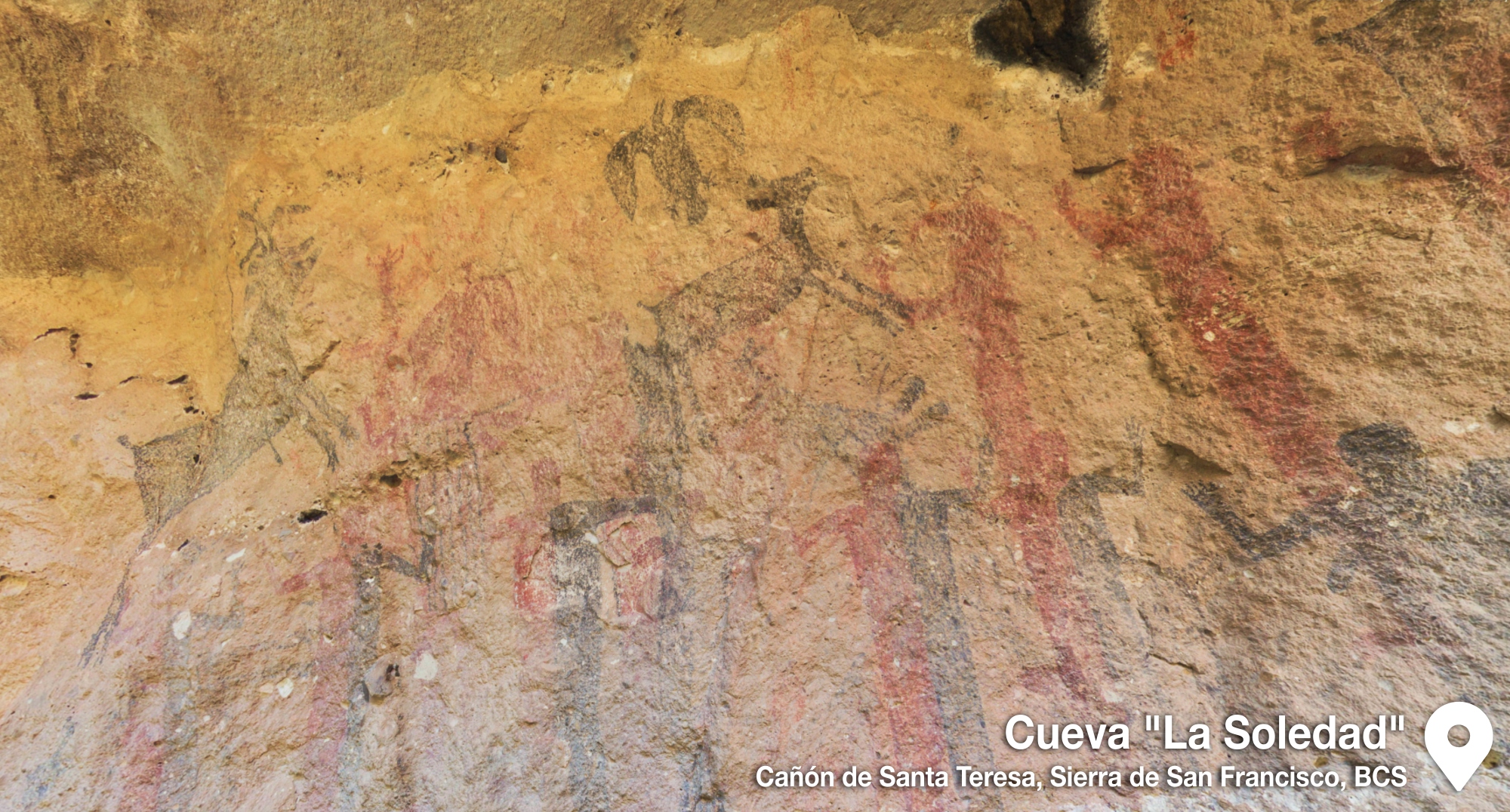Cueva de La Soledad

La Soledad
La cueva de La Soledad es la más cercana a la cueva Pintada y forma parte de lo
que se considera como el conjunto pictórico del cañón de Santa Teresa. Una de
las particularidades de este sitio es el de que la pared que guarda las figuras
está en gran parte recubierto de una capa salitrosa producto de los
escurrimientos pluviales por filtración. Al decir de notables restauradores,
esta capa permite ahora una protección o guarda natural de las pinturas
rupestres de este sitio que no es posible para otras cuevas. Las indagaciones
para ubicar la antigüedad de la presencia humana en la cueva de La Soledad han
arrojado una temporalidad de 6,990 años antes del presente, lo que coloca al
sitio como uno de los más antiguos de los que hasta hoy se han datado en Baja California
Sur. La fecha corresponde a un cordel retorcido que se recuperó mediante una
excavación arqueológica. Las lecturas de las diferentes figuras que aquí se
pueden observar muestran el carácter “realista” de muchísimas de las
representaciones del Gran Mural de la sierra de San Francisco, y en el cual se
pueden apreciar tanto las figuras humanas femeninas como masculinas, las cuales
se despliegan en lo que se sugiere fue una relación de carácter sagrado con
diversos animales marinos y terrestres.
LAS FRONTERAS DEL
GRAN MURAL
La cueva de La Soledad se inscribe en el estilo Sierra de San Francisco de lo que denominamos el “Gran Mural”, cuyos límites van desde la sierra de San Borja y la sierra de San Francisco hasta la caída sur de los lomeríos de la sierra de Guadalupe, justo donde da comienzo otro estilo pictórico llamado de La Giganta, nombre que se lo da la sierra de La Giganta, donde los indígenas creían que vivían “los gigantes”. Paradójicamente, las pinturas rupestres de esta sierra no son como muchas de San Francisco o de la sierra de Guadalupe, “monumentales”, de gran formato, o como llegó a decirse coloquialmente, “hechas por los gigantes”, tan gigantes que no cabían parados en algunas de las cuevas y tenían que tirarse boca arriba sobre el suelo para poder entrar y pintarlas.
LONELINESS
La Soledad cave is the closest to the Pintada cave and is
part of what is considered as the pictorial ensemble of the Santa Teresa
canyon. One of the peculiarities of this site is that the wall that holds the figures
is largely covered with a salty layer resulting from rainwater runoff by
filtration. In the words of notable restaurateurs, this layer now allows a
protection or natural guard of the cave paintings of this site that is not
possible for other caves. The inquiries to locate the antiquity of the human
presence in the cave of La Soledad have thrown a temporality of 6,990 years
before the present, which places the site as one of the oldest of those that
until now have been dated in Baja California Sur . The date corresponds to a
twisted string that was recovered by an archaeological excavation. The readings
of the different figures that can be observed here show the “realistic”
character of many of the representations of the Great Mural of the San Francisco
mountain range, and in which both the female and male human figures can be
appreciated, which are deployed in what is suggested was a relationship of
sacred character with various marine and terrestrial animals.
THE BORDERS OF THE
GREAT WALL
The cave of La Soledad is part of the Sierra de San Francisco style of what we call the "Great Mural", whose limits range from the Sierra de San Borja and the Sierra de San Francisco to the southern fall of the hills of the Sierra de Guadalupe, just where another pictorial style called La Giganta begins, the name given to it by the Sierra de La Giganta, where the indigenous people believed that “the giants” lived. Paradoxically, the cave paintings of this mountain range are not like many of San Francisco or the Sierra de Guadalupe, "monumental", large format, or as colloquially said, "made by the giants", so giant that they could not stand in some of the caves and they had to lie on their backs on the ground in order to enter and paint them.
Detalles
Lugar: Mulegé, Mulegé
Dirección: Camino a San Francisco de la Sierra, Km 36, Mulegé, Baja California Sur
Página web: Sendarupestre.cultura-bcs.gob.mx

